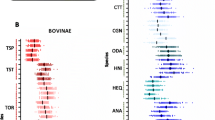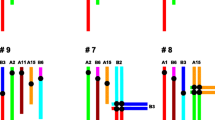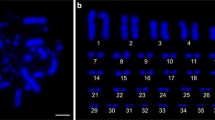Abstract
Homologous chromosomes exchange genetic information through recombination during meiotic synapsis, a process that increases genetic diversity and is fundamental to sexual reproduction. Meiotic studies in mammalian species are scarce and mainly focused on human and mouse. Here, the meiotic recombination events were determined in three species of Platyrrhini monkeys (Cebus libidinosus, Cebus nigritus and Alouatta caraya) by analysing the distribution of MLH1 foci at the stage of pachytene. Moreover, the combination of immunofluorescence and fluorescent in situ hybridisation has enabled us to construct recombination maps of primate chromosomes that are homologous to human chromosomes 13 and 21. Our results show that (a) the overall number of MLH1 foci varies among all three species, (b) the presence of heterochromatin blocks does not have a major influence on the distribution of MLH1 foci and (c) the distribution of crossovers in the homologous chromosomes to human chromosomes 13 and 21 are conserved between species of the same genus (C. libidinosus and C. nigritus) but are significantly different between Cebus and Alouatta. This heterogeneity in recombination behaviour among Ceboidea species may reflect differences in genetic diversity and genome composition.





Similar content being viewed by others
References
Anderson LK, Reeves A, Webb LM, Ashley T (1999) Distribution of crossing over on mouse synaptonemal complexes using immunofluorescent localization of MLH1 protein. Genetics 151:1569–1579
Armada JL, Barroso C, Lima M, Muniz J, Seuanez HN (1987) Chromosome studies in Alouatta belzebul. Am J Primatol 13:283–296
Baker SM, Plug AW, Prolla TA et al (1996) Involvement of mouse Mlh1 in DNA mismatch repair and meiotic crossing over. Nat Genet 13:336–342
Barlow AL, Hulten MA (1998) Crossing over analysis at pachytene in man. Eur J Hum Genet 6:350–358
Basheva EA, Bidau CJ, Borodin PM (2008) General pattern of meiotic recombination in male dogs estimated by MLH1 and RAD51 immunolocalization. Chromosome Res 16:709–719
Bishop DK, Zickler D (2004) Early decision; meiotic crossover interference prior to stable strand exchange and synapsis. Cell 117:9–15
Borodin PM, Karamysheva TV, Belonogova NM, Torgasheva AA, Rubtsov NB, Searle JB (2008a) Recombination map of the common shrew, Sorex araneus (Eulipotyphla, Mammalia). Genetics 178:621–632
Borodin PM, Karamysheva TV, Rubtsov NB (2008b) Immunofluorescent analysis of meiotic recombination and interference in the domestic cat. Tsitologiia 50:62–66
Borodin PM, Basheva EA, Zhelezova AI (2009) Immunocytological analysis of meiotic recombination in the American mink (Mustela vison). Anim Genet 40:235–238
Canevari M, Fernández Balboa C (2003) 100 mamíferos argentinos. Ed Albatros, Buenos Aires
Chebez J, Ruiz Blanco M (2008) Carayá-pitá. In: Chebez JC. Los que se van. Fauna argentina amenazada, vol. 3. Albatros, Buenos Aires, pp 64–69
Clark AG, Wang X, Matise T (2010) Contrasting methods of quantifying fine structure of human recombination. Annu Rev Genomics Hum Genet 11:45–64
Clemente IC, Ponsa M, Garcia M, Egozcue J (1990) Evolution of the Simiiformes and the phylogeny of human chromosomes. Hum Genet 84:493–506
Codina-Pascual M, Campillo M, Kraus J, Speicher MR, Egozcue J, Navarro J, Benet J (2006) Crossover frequency and synaptonemal complex length: their variability and effects on human male meiosis. Mol Hum Reprod 12:123–133
Couturier J, Dutrillaux B (1981) Conservation of replication chronology of homologous chromosome bands between four species of the genus Cebus and man. Cytogenet Cell Genet 29:233–240
de Oliveira EH, Neusser M, Figueiredo WB et al (2002) The phylogeny of howler monkeys (Alouatta, Platyrrhini): reconstruction by multicolor cross-species chromosome painting. Chromosome Res 10:669–683
Dumont BL, Payseur BA (2011) Evolution of the genomic recombination rate in murid rodents. Genetics 187:643–657
Dutrillaux B (1986) Role of chromosomes in evolution: a new interpretation. Ann Genet 29:69–75
Fedigan L, Jack K (2004) The demographic and reproductive context of male replacements in Cebus capucinus. Behaviour 141:755–775
Ferguson KA, Leung S, Jiang D, Ma S (2009) Distribution of MLH1 foci and inter-focal distances in spermatocytes of infertile men. Hum Reprod 24:1313–1321
Feuk L, MacDonald JR, Tang T et al (2005) Discovery of human inversion polymorphisms by comparative analysis of human and chimpanzee DNA sequence assemblies. PLoS Genet 1:e56
Franco MJ, Sciurano RB, Solari AJ (2007) Protein immunolocalization supports the presence of identical mechanisms of XY body formation in eutherians and marsupials. Chromosome Res 15:815–824
Frazer KA, Ballinger DG, Cox DR et al (2007) A second generation human haplotype map of over 3.1 million SNPs. Nature 449:851–861
Froenicke L, Anderson LK, Wienberg J, Ashley T (2002) Male mouse recombination maps for each autosome identified by chromosome painting. Am J Hum Genet 71:1353–1368
Garcia F, Nogues C, Ponsa M, Ruiz-Herrera A, Egozcue J, Garcia Caldes M (2000) Chromosomal homologies between humans and Cebus apella (Primates) revealed by ZOO-FISH. Mamm Genome 11:399–401
Garcia F, Ruiz-Herrera A, Egozcue J, Ponsa M, Garcia M (2002) Chromosomal homologies between Cebus and Ateles (primates) based on ZOO-FISH and G-banding comparisons. Am J Primatol 57:177–188
Garcia-Cruz R, Robles P, Steinberg ER, Camats N, Brieno MA, Garcia-Caldes M, Mudry MD (2009) Pairing and recombination features during meiosis in Cebus paraguayanus (Primates: Platyrrhini). BMC Genet 10:25
Groves C (2001) Primate taxonomy. Smithsonian Institution Press, Washington, p 350
Hassold T, Judis L, Chan ER, Schwartz S, Seftel A, Lynn A (2004) Cytological studies of meiotic recombination in human males. Cytogenet Genome Res 107:249–255
Hassold T, Hansen T, Hunt P, VandeVoort C (2009) Cytological studies of recombination in rhesus males. Cytogenet Genome Res 124:132–138
Kong A, Thorleifsson G, Gudbjartsson DF et al (2010) Fine-scale recombination rate differences between sexes, populations and individuals. Nature 467:1099–1103
Lamb NE, Sherman SL, Hassold TJ (2005) Effect of meiotic recombination on the production of aneuploid gametes in humans. Cytogenet Genome Res 111:250–255
Lenzi ML, Smith J, Snowden T, Kim M, Fishel R, Poulos BK, Cohen PE (2005) Extreme heterogeneity in the molecular events leading to the establishment of chiasmata during meiosis i in human oocytes. Am J Hum Genet 76:112–127
Lima MM, Seuanez HN (1991) Chromosome studies in the red howler monkey, Alouatta seniculus stramineus (Platyrrhini, Primates): description of an X1X2Y1Y2/X1X1X2X2 sex-chromosome system and karyological comparisons with other subspecies. Cytogenet Cell Genet 57:151–156
Lynn A, Koehler KE, Judis L et al (2002) Covariation of synaptonemal complex length and mammalian meiotic exchange rates. Science 296:2222–2225
Lynn A, Ashley T, Hassold T (2004) Variation in human meiotic recombination. Annu Rev Genomics Hum Genet 5:317–349
Megens HJ, Crooijmans RP, Bastiaansen JW et al (2009) Comparison of linkage disequilibrium and haplotype diversity on macro- and microchromosomes in chicken. BMC Genet 10:86
Mudry MD (1990) Cytogenetic variability within and across populations of Cebus apella in Argentina. Folia Primatol (Basel) 54:206–216
Mudry MD, Rahn M, Gorostiaga M, Hick A, Merani MS, Solari AJ (1998) Revised karyotype of Alouatta caraya (Primates: Platyrrhini) based on synaptonemal complex and banding analyses. Hereditas 128:9–16
Mudry MD, Rahn IM, Solari AJ (2001) Meiosis and chromosome painting of sex chromosome systems in Ceboidea. Am J Primatol 54:65–78
Neusser M, Stanyon R, Bigoni F, Wienberg J, Muller S (2001) Molecular cytotaxonomy of New World monkeys (Platyrrhini)—comparative analysis of five species by multi-color chromosome painting gives evidence for a classification of Callimico goeldii within the family of Callithrichidae. Cytogenet Cell Genet 94:206–215
Nieves M, Muhlmann M, Mudry MD (2010) Cebus paraguayanus and Cebus nigritus (Primates, Platyrrhini): a comparative genomic hybridization analysis. Cytogenet Genome Res 128:214–220
Opazo JC, Wildman DE, Prychitko T, Johnson RM, Goodman M (2006) Phylogenetic relationships and divergence times among New World monkeys (Platyrrhini, Primates). Mol Phylogenet Evol 40:274–280
Paigen K, Petkov P (2010) Mammalian recombination hot spots: properties, control and evolution. Nat Rev Genet 11:221–233
Pardo-Manuel de Villena F, Sapienza C (2001) Recombination is proportional to the number of chromosome arms in mammals. Mamm Genome 12:318–322
Petes TD (2001) Meiotic recombination hot spots and cold spots. Nat Rev Genet 2:360–369
Pigozzi MI (2007) Localization of single-copy sequences on chicken synaptonemal complex spreads using fluorescence in situ hybridization (FISH). Cytogenet Genome Res 119:105–112
Pigozzi MI (2008) Relationship between physical and genetic distances along the zebra finch Z chromosome. Chromosome Res 16:839–849
Pigozzi MI, Solari AJ (2005) The germ-line-restricted chromosome in the zebra finch: recombination in females and elimination in males. Chromosoma 114:403–409
Ponsà M, Garcia M, Borrell A et al (1995) Heterochromatin and cytogenetic polymorphisms in Cebus apella (Cebidae, Platyrrhini). Am J Primatol 37:325–331
Ptak SE, Hinds DA, Koehler K et al (2005) Fine-scale recombination patterns differ between chimpanzees and humans. Nat Genet 37:429–434
Qanbari S, Pimentel EC, Tetens J, Thaller G, Lichtner P, Sharifi AR, Simianer H (2010) The pattern of linkage disequilibrium in German Holstein cattle. Anim Genet 41:346–356
Rahn MI, Mudry M, Merani MS, Solari AJ (1996) Meiotic behavior of the X1X2Y1Y2 quadrivalent of the primate Alouatta caraya. Chromosome Res 4:350–356
Reeves A (2001) MicroMeasure: a new computer program for the collection and analysis of cytogenetic data. Genome 44:439–443
Robinson TJ, Ruiz-Herrera A (2008) Defining the ancestral eutherian karyotype: a cladistic interpretation of chromosome painting and genome sequence assembly data. Chromosome Res 16:1133–1141
Robles P, Roig I, Garcia R et al (2009) Analysis of recombination along chromosome 21 during human female pachytene stage. Reprod Biomed Online 18:784–794
Rogers J, Garcia R, Shelledy W et al (2006) An initial genetic linkage map of the rhesus macaque (Macaca mulatta) genome using human microsatellite loci. Genomics 87:30–38
Seuánez HN, Armada JL, Barroso C, Rezende C, da Silva VF (1983) The meiotic chromosomes of Cebus apella (Cebidae, Platyrrhini). Cytogenet Cell Genet 36:517–524
Stanyon R, Garofalo F, Steinberg ER, Capozzi O, Di Marco S, Nieves M, Archidiacono N, Mudry MD (2011) Chromosome painting in two genera of South American monkeys: species identification, conservation and management. Cytogenet Genome Res 134:40–50
Steinberg ER, Nieves M, Mudry MD (2007) Meiotic characterization and sex determination system of neotropical primates: Bolivian squirrel monkey Saimiri boliviensis (primates: Cebidae). Am J Primatol 69:1236–1241
Steinberg ER, Cortes-Ortiz L, Nieves M et al (2008) The karyotype of Alouatta pigra (Primates: Platyrrhini): mitotic and meiotic analyses. Cytogenet Genome Res 122:103–109
Sun F, Oliver-Bonet M, Liehr T et al (2004) Human male recombination maps for individual chromosomes. Am J Hum Genet 74:521–531
Tease C, Hartshorne GM, Hulten MA (2002) Patterns of meiotic recombination in human fetal oocytes. Am J Hum Genet 70:1469–1479
Wu ZK, Getun IV, Bois PR (2010) Anatomy of mouse recombination hot spots. Nucleic Acids Res 38:2346–2354
Yunis J, Prakash O (1982) The origin of man: a chromosomal pictorial legacy. Science 215:1525–1530
Acknowledgments
We are grateful to Dr. C. Heyting and Dr. M. Fritzler for their generous gifts of antibodies. We thank L.Uroz, G. Elkorchi and J. del Rey for technical support. Ignasi Roig is acknowledged for comments on an earlier version of this manuscript and Mariela Nieves for her suggestions on the last draft. We are also thankful to the editor and two anonymous reviewers whose comments and suggestions improved the manuscript. All research reported in this manuscript has met the appropriate national and institutional guidelines for the legal acquisition and use of laboratory animals and authorised study of wild animals. The authors also adhered to the Guide for Care and Use of Experimental Animals, as promulgated by the Canadian Council of Animal Care, and to the American Society of Primatologists (ASP) Principles for the Ethical Treatment of Non-human Primates. The work, which took place in Argentina, was done in accordance with the laws of Argentina. We have received funds from PCI2005-A7-O428, MDM PIP 5012, UBACyTX107, PRP2006-02, BFU2006-12951, 2009SGR1107 and CGL2010-20170. The English of this manuscript has been proofread by a native, English-speaking University Instructor of English.
Author information
Authors and Affiliations
Corresponding authors
Additional information
Communicated by: S. Keeney
A. Ruiz-Herrera and M. Garcia-Caldés contributed equally to this work.
Rights and permissions
About this article
Cite this article
Garcia-Cruz, R., Pacheco, S., Brieño, M.A. et al. A comparative study of the recombination pattern in three species of Platyrrhini monkeys (primates). Chromosoma 120, 521–530 (2011). https://doi.org/10.1007/s00412-011-0329-6
Received:
Revised:
Accepted:
Published:
Issue Date:
DOI: https://doi.org/10.1007/s00412-011-0329-6




